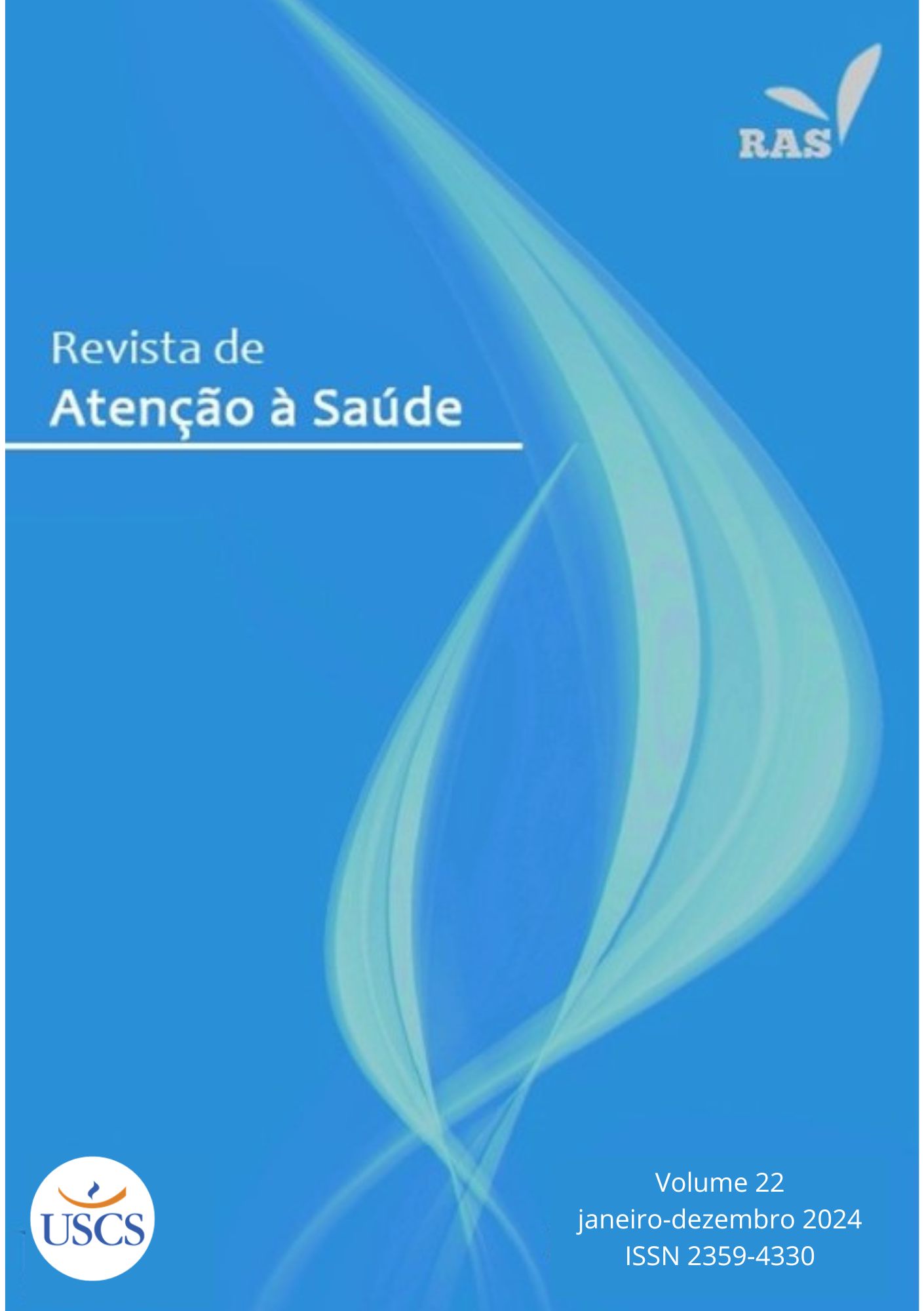SARI by COVID-19 in Ituiutaba-MG: analysis of the demographic, clinical and mortality profiles in the first 13 epidemiological weeks of 2021
Demographic, clinical and mortality profile for COVID-19 in Ituiutaba-MGin the first 13 epidemiological weeks of 2021
DOI:
https://doi.org/10.13037/ras.vol22.e202492228Keywords:
SARS-CoV-2, Vigilância Epidemiológica, Doença CrônicaAbstract
Introduction: Epidemiological waves of COVID-19 have been observed in Brazil from studies that evaluate the profile of the notifications in different databases. This is useful to better understand the dynamic of the virus and disease, which enables the adoption of effective sanitary measures, to control hospital supplies and the organization of the medical care. Objective: To describe the demographical, clinical and of hospitalization features of the laboratory-confirmed patients COVID-19 treated at the health service of Ituiutaba-MG until the 13ª epidemiological week of 2021. Methods: Cross-sectional study was performed comparing the profile of hospitalized and deaths of patients by consulting the individual registration forms for severe acute respiratory illness (SARI) cases, test-confirmed of COVID-19 and death certificate. Demographical, clinical and hospitalization data were analyzed by descriptive statistic, considering relative frequency (%), mean and confidence interval, and for the non-homogeneous distributions were used median and interquartile shift. The comparison between the hospital discharge and death groups were performed by the T and Mann-Whitney tests. Results: Of the total of 292 notifications evaluated, 138 patients died, with the prevalence of men, aged over 65 years of race declared as white, with cardiovascular disease and/or diabetes as a comorbid and that were hospitalized by more time, necessity of intensive care unit and use of ventilatory support. Conclusions: The data revealed that the factor age and comorbid are preponderant to a higher severity of the COVID-19.
Downloads
References
Mahase E. Covid-19: Portugal closes all medical schools after 31 cases confirmed in the country. BMJ. 2020;368:m986.
Covid-19 no Brasil. Accessed June 28, 2023. https://infoms.saude.gov.br/extensions/covid-19_html/covid-19_html.html
Brasil. Secretaria de Atenção Especializada à Saúde. Departamento de Atenção Hospitalar D e de Urgência. Protocolo de Manejo Clínico Da Covid-19 Na Atenção Especializada. Vol 1. Ministério da Saúde; 2020. www.saude.gov.br
Brasil. Departamento de Análise em Saúde e Doenças não Transmissíveis. Guia de Vigilância Epidemiológica Emergência de Saúde Pública de Importância Nacional Pela Doença Pelo Coronavírus 2019 – Covid-19. Vol 1. Ministério da Saúde; 2021.
Castro MC, Kim S, Barberia L, et al. Spatiotemporal Pattern of COVID-19 Spread in Brazil. https://www.science.org
Michelon CM. Main SARS-CoV-2 variants notified in Brazil. Revista Brasileira de Análises Clínicas. 2021;53(2). doi:10.21877/2448-3877.202100961
Victora CG, Castro MC, Gurzenda S, Medeiros AC, França GVA, Barros AJD. Estimating the early impact of vaccination against COVID-19 on deaths among elderly people in Brazil: Analyses of routinely-collected data on vaccine coverage and mortality. EClinicalMedicine. 2021;38. doi:10.1016/j.eclinm.2021.101036
Flook M, Jackson C, Vasileiou E, et al. Informing the public health response to COVID-19: a systematic review of risk factors for disease, severity, and mortality. BMC Infect Dis. 2021;21(1). doi:10.1186/s12879-021-05992-1
Rod JE, Oviedo-Trespalacios O, Cortes-Ramirez J. A brief-review of the risk factors for covid-19 severity. Rev Saude Publica. 2020;54. doi:10.11606/S1518-8787.2020054002481
De Souza Noronha KVM, Guedes GR, Turra CM, et al. The COVID-19 pandemic in Brazil: Analysis of supply and demand of hospital and ICU beds and mechanical ventilators under different scenarios. Cad Saude Publica. 2020;36(6). doi:10.1590/0102-311x00115320
Instituto Brasileiro de Geografia e Estatística (IBGE). IBGE Cidades. Published 2023. Accessed June 29, 2023. https://cidades.ibge.gov.br/
Bertolucci L. Análise Demográfica da Mesorregião do Triângulo Mineiro e Alto Paranaíba - TMAP. In: Dinâmica Socioeconômica Da Mesorregião Do Triângulo Mineiro e Alto Paranaíba. Vol 1. CEPES/IEUFU; 2017:1-48. http://www.ie.ufu.br/CEPES
Ministério da Saúde. Ficha de registro individual - Casos de Síndrome respiratória aguda grave hospitalizado. Published 2022. Accessed June 29, 2023. http://www.vs.saude.ms.gov.br/wp-content/uploads/2019/11/Ficha-SIVEP_GRIPE-SRAG_Hospital.pdf
World Health Organization (WHO). WHO Coronavirus (COVID-19) Dashboard. Published 2023. Accessed June 29, 2023. https://covid19.who.int/table
Magno L, Rossi TA, de Mendonça-Lima FW, et al. Challenges and proposals for scaling up COVID-19 testing and diagnosis in Brazil. Ciencia e Saude Coletiva. 2020;25(9):3355-3364. doi:10.1590/1413-81232020259.17812020
de Souza WM, Buss LF, Candido D da S, et al. Epidemiological and clinical characteristics of the COVID-19 epidemic in Brazil. Nat Hum Behav. 2020;4(8):856-865. doi:10.1038/s41562-020-0928-4
de Paiva KM, Hillesheim D, Rech CR, et al. Prevalence and associated factors of SARS by COVID-19 in adults and aged people with chronic cardiovascular disease. Arq Bras Cardiol. 2021;117(5):968-975. doi:10.36660/abc.20200955
Bastos LS, Niquini RP, Lana RM, et al. COVID-19 and hospitalizations for SARI in Brazil: A comparison up to the 12th epidemiological week of 2020. Cad Saude Publica. 2020;36(4). doi:10.1590/0102-311X00070120
Pacheco Souza G, Alexsander Martins Lara R, Gualberto Souza I, et al. Análise epidemiológica do COVID-19 no estado de Minas Gerais. Revista de Atenção à Saúde. 2021;19(68). doi:10.13037/ras.vol19n68.7655
Instituto Brasileiro de Geografia e Estatística (IBGE). PNAD Contínua – Pesquisa Nacional por Amostras de Domicílios Contínua. Published 2023. Accessed June 29, 2023. https://www.ibge.gov.br/estatisticas/sociais/habitacao/17270-pnad-continua.html
Bhering G da S, Coelho FA, Mata JB. Perfil das hospitalizações por coronavírus disease-2019 (COVID-19) no estado de Minas Gerais, Brasil: dados preliminares do Sistema de Informação Hospitalar (SIH/SUS), 2020-2021. Revista Científica INOFAGOC. 2022;7(1):8-17.
Wu C, Chen X, Cai Y, et al. Risk Factors Associated with Acute Respiratory Distress Syndrome and Death in Patients with Coronavirus Disease 2019 Pneumonia in Wuhan, China. JAMA Intern Med. 2020;180(7):934-943. doi:10.1001/jamainternmed.2020.0994
Mesenburg MA, Hallal PC, Menezes AMB, et al. Chronic non-communicable diseases and COVID-19: EPICOVID-19 Brazil results. Rev Saude Publica. 2021;55:1-11. doi:10.11606/S1518-8787.2021055003673
Malta DC, Gomes CS, da Silva AG, et al. Uso dos serviços de saúde e adesão ao distanciamento social por adultos com doenças crônicas na pandemia de COVID-19, Brasil, 2020. Ciência e Saúde Coletiva. 2021;26(7):2833-2842.
Santos KOB, de Cássia Pereira Fernandes R, de Almeida MMC, Miranda SS, Mise YF, de Lima MAG. Labor, health and vulnerability in the COVID-19 pandemic. Cad Saude Publica. 2021;36(12). doi:10.1590/0102-311X00178320
Sallas J, Elidio GA, Costacurta GF, et al. Decrease in compulsory notifications registered by the Brazilian National Hospital Epidemiological Surveillance Network during the COVID-19 pandemic: a descriptive study, 2017-2020. Epidemiologia e Servicos de Saude. 2022;31(1). doi:10.1590/S1679-49742022000100011
Mehta S, Machado F, Kwizera A, et al. COVID-19: a heavy toll on health-care workers. Lancet Respir Med. 2021;9:226-228. doi:10.1016/S2213-2600(20)30524-5
Klokner SGM, Luz RA da, Araujo PH de M, et al. Perfil epidemiológico e preditores de fatores de risco para a COVID-19 na região sul do Brasil. Research, Society and Development. 2021;10(3):e17710313197. doi:10.33448/rsd-v10i3.13197
Daumas RP, Azevedo e Silva G, Tosca R, et al. O papel da atenção primária na rede de atenção à saúde no Brasil: limites e possibilidades no enfretamento da COVID-19. Cad Saúde Pública. 2020;36(6):e00104120.
Wu Z, McGoogan JM. Characteristics of and Important Lessons from the Coronavirus Disease 2019 (COVID-19) Outbreak in China: Summary of a Report of 72314 Cases from the Chinese Center for Disease Control and Prevention. JAMA - Journal of the American Medical Association. 2020;323(13):1239-1242. doi:10.1001/jama.2020.2648
Zafer MM, El-Mahallawy HA, Ashour HM. Severe COVID-19 and sepsis: Immune pathogenesis and laboratory markers. Microorganisms. 2021;9(1):1-13. doi:10.3390/microorganisms9010159
Li H, Liu L, Zhang D, et al. SARS-CoV-2 and viral sepsis: observations and hypotheses. The Lancet. 2020;395(10235):1517-1520. doi:10.1016/S0140-6736(20)30920-X
Dremsizov T, Clermont G, Kellum JA, Kalassian KG, Fine MJ, Angus DC. Severe sepsis in community-acquired pneumonia: When does it happen, and do systemic inflammatory response syndrome criteria help predict course? Chest. 2006;129(4):968-978. doi:10.1378/chest.129.4.968
Patil M, Singh S, Henderson J, Krishnamurthy P. Mechanisms of COVID-19-induced cardiovascular disease: Is sepsis or exosome the missing link? J Cell Physiol. 2021;236(5):3366-3382. doi:10.1002/jcp.30109
Corrales-Medina VF, Musher DM, Shachkina S, Chirinos JA. Acute pneumonia and the cardiovascular system. The Lancet. 2013;381(9865):496-505. doi:10.1016/S0140-6736(12)61266-5.
Downloads
Published
Issue
Section
License
Copyright (c) 2024 Gustavo Siconello dos Santos, Victor Antonio Ferreira Freire, Ana Karen Costa Silva, Carlla Aparecida Oliveira, Luciana Karen Calábria, Alexandre Azenha Alves de Rezende

This work is licensed under a Creative Commons Attribution-NonCommercial-NoDerivatives 4.0 International License.
Policy Proposal for Journals offering Free Delayed Access
Authors who publish in this magazine agree to the following terms:
- Authors maintain the copyright and grant the journal the right to the first publication, with the work simultaneously licensed under a Creative Commons Attribution License after publication, allowing the sharing of the work with recognition of the authorship of the work and initial publication in this journal.
- Authors are authorized to assume additional contracts separately, for non-exclusive distribution of the version of the work published in this magazine (eg, publishing in institutional repository or as a book chapter), with the acknowledgment of the authorship and initial publication in this journal.
- Authors are allowed and encouraged to publish and distribute their work online (eg in institutional repositories or on their personal page) at any point before or during the editorial process, as this can generate productive changes, as well as increase impact and citation of the published work (See The Effect of Open Access).









